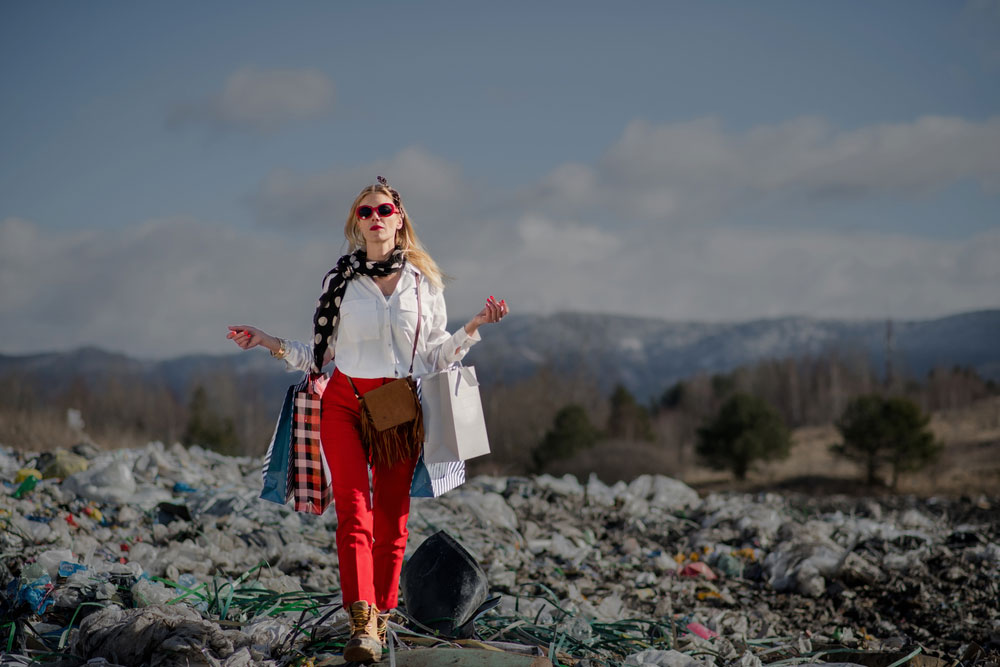How Fast Fashion is Bad for the Environment

Yves Saint Laurent was once quoted as saying, “fashions fade, style is eternal.” Sadly, with the arrival of the fast fashion movement, fashion these days does not have a chance to fade, it is almost immediately replaced with something new, as quickly as it arrives. Coupled with the immediacy of social media, the need to appear relevant, and to have all the latest things, fashion has morphed to meet the demands of the consumer.
Unfortunately, with the high turnover in fashionable clothing and the latest trends there is a devastating environmental cost that comes alongside this form of clothing production.
What is Fast Fashion?
Fast fashion is fashion that is designed and manufactured quickly. It is a business model that prioritizes speed and low cost to deliver frequent new collections. These new clothes are often inspired by the latest fashion-house looks or celebrity styles.
Typically, clothes that fall into the fast fashion category are not designed with quality, sustainability, or longevity in mind. Instead, these garments are designed to be cheap to buy, typically attracting a fashion hungry consumer that is aiming to wear the latest trends and get style on a budget.
Over the last quarter of a century, the fast fashion industry has grown exponentially. This growth has impacted the more traditional fashion houses as they now have to produce more fresh styles to counteract the low-price copies.
Once, fashion cycles used to consist of two releases a year (spring / summer and autumn / winter), but this has turned into a constant stream of new collections. Historically, people would invest in their clothing and keep them until they wore out, but today fast fashion has created a surge in consumption, with consumers buying many more garments and discarding them on a more frequent basis.
Unfortunately, the demand for cheap and fast fashion leads to an array of environmental problems. From high energy consumption, excessive water use, toxic chemical discharge, to waste generation, fast fashion’s environmental and carbon footprint is significant.
How is Fast Fashion Bad for the Environment?
Fast Fashion has an impact on the environment at each of its various stages in the production and consumption cycle.
The production of clothing involves extraction of raw materials, manufacturing, and transportation. Each of these stages uses significant amounts of resources and energy, each contributing to environmental degradation and climate change through the emission of greenhouse gases.
Once the clothes are no longer trendy, they are discarded. Due to the way the fast fashion business model works, the products are not often designed with longevity in mind. Even if the consumer wishes to keep the item of clothing for longer, the inherent quality of the item means that they disintegrate and wear out much faster than traditionally manufactured garments.
With fast fashion, the frequency of the clothing that ends up being discarded is dramatically increased and it often ends up in landfills or is incinerated, causing further environmental damage.
The constant production and disposal cycle of fast fashion exacerbates environmental issues at every stage of the lifecycle. For example, Roundup have stated that 87% of the materials used to manufacturer clothing ends up in landfill.
To take a simple example, cotton, a raw material that is commonly found in fast fashion clothing, requires a substantial amount of water and chemicals for it to be made into a usable material. It might be assumed that a natural material such as cotton is better for the environment than a synthetic fibre, but that is not always the case depending on how the material is manufactured. The mass demand of any material has some kind of cost to the environment and when it comes to fast fashion, this cost becomes excessive.
With regards to this environmental cost, as Earth.org reports – the sales of fashion has doubled over a fifteen year period while the number of times an item of clothing is worn before it is discarded has dropped by 36%. The stats suggest that consumers have been buying more items of clothing and in turn, wearing them much less regularly.
Another problem is that in many cases, clothing is made in factories that are located in developing countries and the garments then need to be transported to the market that they will be sold in. This transportation of garments from factories to retailers and then the consumer additionally contributes to carbon emissions.
Fast Fashion and Climate Change
As highlighted by the BBC – The fast fashion industry is responsible for approximately 10% of global carbon emissions and 20% of waste water. From resource extraction and energy-intensive manufacturing to logistics and waste management, every stage of the fast fashion life cycle contributes to greenhouse gas emissions, exacerbating global warming.
Moreover, the industry’s heavy reliance on fossil fuel-based natural resources to make synthetic fabrics make the problem worse and add to the climate crisis.
Not only does the production of these fabrics emit greenhouse gases, but the use of synthetic fibres means they may contain plastic, which is typically non-biodegradable, further impacting the environment after they been thrown away.
One key take away is that that the UN have stated that they believe that the fashion industry is the second most polluting industry in the world.
Impacts of Fast Fashion on Plastic Pollution
Fast fashion’s contribution to plastic pollution is another aspect of its environmental impact. Synthetic fabrics like polyester, polypropylene, acrylic, and nylon are made using fossil fuels, and these are materials that are commonly used in fast fashion due to their low cost.
Synthetic fibres are made from plastic and are non-biodegradable, adding to the growing problem of plastic pollution. Washing synthetic clothes is one of the biggest causes of microplastics entering the waterways, as it escapes the filters and ends up in the rivers and the oceans.
end up in rivers and oceans, causing harm to aquatic life.
These microfibers, along with discarded plastic-based garments, are large contributors to the plastic waste found in the world’s oceans. It is estimated that synthetic fibres account for 35% of microplastics found in oceans.
Environmental Impacts of Fast Fashion
Fast fashion’s impact extends beyond climate change and plastic pollution. It also poses a threat to biodiversity. Textile production’s demand for raw materials leads to habitat destruction, soil degradation, and water pollution, affecting a variety of species.
Take cotton farming, for example. It not only uses pesticides which harms soil health and kills beneficial insects, but it can also lead to water scarcity.
Cotton is the main material used in denim and jean manufacture. The impact of jean manufacture on water usage is huge – The American company Levi Strauss Co estimate that a pair of jeans uses 3,800 litres of water in its lifetime, and with that in mind are looking at ways this can be reduced. However, unlike Levi Strauss many of the fast fashion brands are less inclined to make similar ecological commitments.
To see how cotton production has been so damaging, you only need to examine The Aral Sea tragedy, where unsustainable cotton farming has led to one of the world’s largest lakes drying up.
The pollution of freshwater rivers due to untreated toxic chemical and textile dyeing discharge from clothing factories is a common occurrence. Often, this occurs in countries where clothing manufacturer is outsourced to, such as China, Bangladesh, and India. This is another way the global fashion industry has a disregard for the ecosystems they operate alongside.
The social impact of fast fashion should not be overlooked either – with garment workers in developing countries experiencing low wages, poor working conditions and at worse human rights violations.
Sustainable Fashion
Many people have become aware of the problems with fast fashion and analysts have even predicted that there will be a decline in revenue generated from fast fashion brands over the next ten years. That is good news, but that is not to say that fast fashion is not a problem as it is still a massive market.
Governments are stepping in to legislate to address the issue of fast fashion with policy designed to tackle fabric quality and to tackle the fact that a lot of unsold clothing is commonly destroyed. Reducing textile waste is an important aspect of improving the life cycle of these materials. Ensuring that clothing and fabric materials can be recycled and reused as a part of the circular economy is the way forward for the fashion industry.
Affordable fashion still needs to be available for those individuals on a budget. While low prices are attractive to some, the low-quality manufacturing methods means that people need to replace clothes more frequently. Initiatives that focus on good value clothing that is well made, have become more common in recent years.
Second hand clothing is an option for those looking to reduce their consumption of brand-new items. Vintage clothing has a thriving marketplace both online and on the high-street in boutiques. More people are now looking to second-hand clothing stores or online shops that specialize in vintage or designer garments. These have always been popular but are even more so now with a new drive for better sustainability.
Sustainable fashion brands and the slow fashion movement is becoming popular. People are keeping their old clothes for longer and now there is a greater awareness of environmental matters. Shoppers are now more likely to consider sustainable brands and eco materials when shopping for new garments. Many people have come to realize that overconsumption is problematic and needs to be addressed.
Lower-impact textiles and sustainable natural fabrics are also more prevalent. Organic cotton and recycled cotton are both on the rise. Today, if you shop around you can buy jeans and t-shirts that are manufactured from these more sustainable materials.
There is a move away from synthetic fabrics to those that are more sustainable and take the environment into consideration. Popular sustainable fabrics include organic plant-based fabrics such as organic hemp and animal-based fabrics such as wool.
The Role of Consumers in Fast Fashion
The fast fashion industry’s environmental impact is undeniable. The solution to the issues surrounding fast fashion is directly in the consumer’s hands. Without the demand for these products then fast fashion brands would not have a working business model.
Corporates tend to be slow to change their ways unless forced to by legislation or if their brand reputation is at stake due to campaign groups highlighting their poor manufacturing practices.
Consumers need to shift their mind-set and avoid replacing their clothing frequently, and instead place value on quality and longevity.
In fact, it is consumers who ultimately play the pivotal role in limiting the fast fashion industry’s environmental impact.
Shoppers should demand transparency and accountability from fashion brands. Asking questions and researching a brand’s supply chain, manufacturing practices, and waste management processes can push the industry towards more sustainable practices.
Aside from slow-moving legislation, if we want the fashion industry to change its ways and move away from fast fashion practices, the quickest and simplest solution is for the consumer to change their buying habits when it comes to purchasing new clothes.
How the Plastic Collective Helps
The Plastic Collective helps to tackle the plastic problem in several innovative ways.
The Plastic Collective supports businesses looking to reduce their plastic footprint by guiding them in using an innovative plastic offsetting scheme. The Plastic Collective helps a business to directly reduce their plastic consumption and use.
The Plastic Collective also collaborates with communities to help reduce plastic waste. We provide education programs and supply machinery to communities to build sustainable plastic recycling micro-enterprises.

